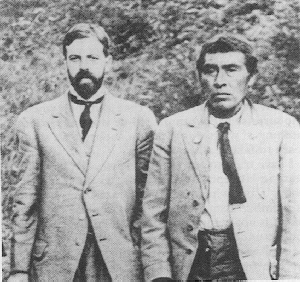- Alfred L. Kroeber
Infobox Person
name = Alfred L. Kroeber

image_size = 250px
caption = Alfred L. Kroeber withIshi in 1911.
birth_date = June 11, 1876
birth_place =Hoboken, New Jersey
death_date = October 5, 1960
death_place =
education =Columbia University
occupation =Anthropologist
spouse = (2) Theodora Kracaw
parents =
children = Karl, Ursula, Ted, Clifton.Alfred Louis Kroeber (June 11, 1876–October 5, 1960) was one of the most influential figures in American
anthropology in the first half of the twentieth century.Kroeber was born in
Hoboken, New Jersey and attended Columbia College at the age of 16, earning an A.B. in English in 1896, and an M.A. in Romantic drama in 1897. He received his doctorate underFranz Boas atColumbia University in 1901, basing his dissertation on decorative symbolism on his field work among theArapaho . It was the first doctorate in anthropology awarded by Columbia. He spent most of his career inCalifornia , primarily at theUniversity of California, Berkeley where he worked as both a Professor of Anthropology and the Director of what was then The University of California Museum of Anthropology (now thePhoebe A. Hearst Museum of Anthropology ). The anthropology department's headquarters building at the University of California is known as Kroeber Hall. He was associated with Berkeley until his retirement in 1946.Although he is known primarily as a cultural anthropologist, he did significant work in
archaeology , and he contributed to anthropology by making connections between archaeology and culture. He conducted excavations inNew Mexico ,Mexico , andPeru . Kroeber and his students did important work collecting cultural data on western tribes of Native Americans. The work done in preserving information about California tribes appeared in "Handbook of Indians of California" (1925). These efforts to preserve remaining data on these tribes has been termed "Salvage ethnography ." He is credited with developing the concepts of Culture Area and Culture Configuration ("Cultural and Natural Areas of Native North America", 1939).His influence was so strong that many contemporaries adopted his style of beard and mustache as well as his views as a social scientist. During his lifetime, he was known as the "Dean of American anthropologists". His anthropological
paradigm s have introduced the word "" into the English language. Kroeber and Roland Dixon were very influential in the genetic classification ofNative American languages in North America, being responsible for groupings such as Penutian and Hokan. He is noted for working withIshi , who was claimed (though not uncontroversially) to be the lastCalifornia Yahi Indian. His second wife,Theodora Kroeber , wrote a well-known biography of Ishi, "Ishi in Two Worlds". Kroeber's relationship with Ishi was made into a film "The Last of His Tribe" (1992), starringJon Voigt as Kroeber. His textbook, "Anthropology" (1923, 1948), was widely used for years, and was one of ten books required for all students during their first year at Columbia in the late 1940s.Kroeber was father of the academic
Karl Kroeber and the writer (primarily offantasy andscience fiction )Ursula K. Le Guin by his second wife, Theodora. He also adopted the two children of Theodora's first marriage, Ted and historianClifton Kroeber . Clifton and Karl recently (2003) edited a book together on the Ishi case, "Ishi in Three Centuries." This is the first scholarly book on Ishi to contain essays by Indians.Partial list of works
* "Indian Myths of South Central California" (1907), in "University of California Publications in American Archaeology and Ethnology" 4:167-250. Berkeley (Six "Rumsien Costanoan" myths, pp. 199-202); online at [http://www.sacred-texts.com/nam/ca/scc Sacred Texts] .
* "The Religion of the Indians of California" (1907), in "University of California Publications in American Archaeology and Ethnology" 4:6. Berkeley, sections titled "Shamanism", "Public Ceremonies", "Ceremonial Structures and Paraphernalia", and "Mythology and Beliefs"; available at [http://www.sacred-texts.com/nam/ca/ric Sacred Texts]
* "Handbook of the Indians of California" (1925). Washington, D.C: "Bureau of American Ethnology Bulletin" No. 78.References
: cite book |author=aut|Darnell, Regna |authorlink=Regna Darnell|year=2001 |title=Invisible Genealogies: A History of Americanist Anthropology |series=Critical studies in the history of anthropology series, nowrap|vol. 1 |location=Lincoln |publisher=
University of Nebraska Press |isbn=0-8032-1710-2 |oclc=44502297: cite book |author=aut|Kroeber, Theodora |authorlink=Theodora Kroeber |year=1970 |title=Alfred Kroeber; A Personal Configuration |location=Berkeley and Los Angeles |publisher=University of California Press |isbn=0-520-03720-0 |oclc=6202748: cite book |author=aut|Wolf, Eric R. |authorlink=Eric Wolf |year=2004 |chapter=Alfred L. Kroeber|editor=Sydel Silverman (ed.)|title=Totems and Teachers: Key Figures in the History of Anthropology |edition=2nd edition |location=Walnut Creek, CA |publisher=AltaMira Press |pages=pp.27–50|isbn=0-7591-0459-X |oclc=52373442External links
* [http://www.lib.berkeley.edu/MRC/audiofiles.html#kroeber Sex in Natural History (talk at UC Berkeley, 1956) (online audio recording)]
* [http://www.americanethnography.com/article_sql.php?id=10 American Ethnography -- Kroeber's obituary, written by Julian H. Steward]
Wikimedia Foundation. 2010.
